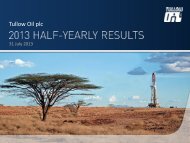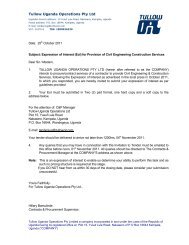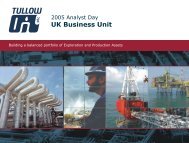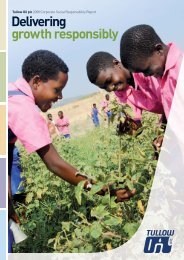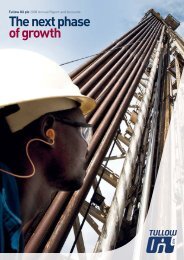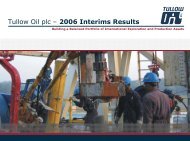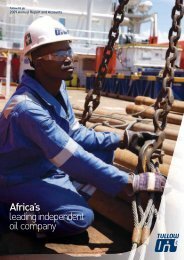Download the CR Report PDF (1.90MB) - Tullow Oil plc
Download the CR Report PDF (1.90MB) - Tullow Oil plc
Download the CR Report PDF (1.90MB) - Tullow Oil plc
You also want an ePaper? Increase the reach of your titles
YUMPU automatically turns print PDFs into web optimized ePapers that Google loves.
The Environment<br />
continued<br />
Water usage<br />
As part of daily operations, <strong>the</strong> Bacton<br />
Terminal extracts water from <strong>the</strong> underlying<br />
aquifer, via two wells, for use in <strong>the</strong> gas<br />
refining process and as a supply for fire-water.<br />
Water usage is highly regulated by <strong>the</strong><br />
Environmental Agency (EA) to control total<br />
consumption. Consented limits allow Bacton<br />
to extract, on an annual basis, 47,700 m 3 of<br />
water. In each year, water usage has been<br />
within <strong>the</strong> consented limits and a significant<br />
year-on-year reduction has been achieved<br />
since 2004. In 2006, water usage was 61%<br />
below <strong>the</strong> consented limit and was 36%<br />
below water usage in <strong>the</strong> previous year.<br />
Spills<br />
In 2006, <strong>Tullow</strong> had two reportable spills.<br />
On 19 February, a total of 0.00937 tonnes<br />
of diesel spilled during an uploading activity<br />
on <strong>the</strong> Hewett 48/29C facility. On 24 April,<br />
<strong>the</strong>re was a reportable chemical spill relating<br />
to a sub-sea leak on <strong>the</strong> Hewett 48/29A that<br />
required intervention from a dive support<br />
vessel. The total spill was 6.3 tonnes.<br />
The actual chemical involved has a low<br />
environmental impact and is actually<br />
authorised under <strong>the</strong> chemical regulations<br />
to be utilised and discharged in <strong>the</strong> same<br />
manner in which it was spilt. However,<br />
because this was not a controlled discharge<br />
it was reported in line with permit conditions.<br />
In 2004 and 2005, <strong>the</strong> Group had no<br />
significant spills.<br />
ISO 14001 environmental certification<br />
In May 2006, <strong>Tullow</strong> <strong>Oil</strong> <strong>plc</strong> achieved<br />
ISO 14001 certification for <strong>the</strong> Group’s<br />
corporate environmental management<br />
system, <strong>the</strong> IMS. This was an amendment<br />
to <strong>the</strong> scope of certification which, since<br />
May 2003, covered our UK operations and<br />
<strong>the</strong> Bacton Gas Terminal. The corporate<br />
system has been tested in <strong>the</strong> UK and<br />
Pakistan business units and <strong>the</strong>y have been<br />
appended to <strong>the</strong> certificate. During 2007,<br />
we expect Bangladesh and Dublin to be<br />
independently audited and added to <strong>the</strong><br />
certificate. We expect <strong>the</strong> number of verified<br />
group operations to increase steadily in <strong>the</strong><br />
years ahead as part of <strong>the</strong> surveillance audits.<br />
Improving how we record<br />
During <strong>the</strong> year, we refined and enhanced<br />
Accident and Incident Investigation<br />
procedures to improve categorisation and<br />
investigation of an incident at <strong>the</strong> time and<br />
to ensure reporting to <strong>the</strong> appropriate level.<br />
These new procedures are in place since<br />
1 January, 2007. All health and safety<br />
incidents, above medium potential, receive<br />
immediate senior management attention<br />
and are reported to <strong>the</strong> executive Directors<br />
on a monthly basis and <strong>the</strong> <strong>Tullow</strong> Board<br />
bi-annually. If a significant incident occurred<br />
this would be reported to senior management<br />
immediately. We analyse incidents to ensure<br />
that we identify <strong>the</strong> root cause, understand<br />
what <strong>the</strong> causal factors were and implement<br />
<strong>the</strong> learnings from an incident to improve<br />
our performance going forward.<br />
Biodiversity management<br />
Biodiversity is a collective term that is<br />
used to describe <strong>the</strong> complexity of all life,<br />
including <strong>the</strong> great variety of organisms and<br />
<strong>the</strong>ir behaviours and interactions. In effect,<br />
it is <strong>the</strong> wide range of animals, plants,<br />
organisms, climatic conditions and unique<br />
characteristics which exist in an area or<br />
ecosystem. Any new entrant into that<br />
ecosystem, if not very carefully planned<br />
and managed, can have a long-term effect.<br />
The management of biodiversity is an<br />
important consideration for any organisation<br />
in <strong>the</strong> development of a sustainable<br />
long-term business, particularly for<br />
companies in <strong>the</strong> oil and gas industry.<br />
For <strong>Tullow</strong>, our goal is to preserve<br />
biodiversity, and this objective is embedded<br />
in our EHS policies and how we conduct<br />
our activities. In practical terms, we carried<br />
out specific assessments of biodiversity in<br />
Pakistan, Bangladesh and Uganda in <strong>the</strong><br />
fourth quarter of 2006, to confirm that <strong>the</strong>re<br />
were no protected areas or environmentallysensitive<br />
sites in <strong>the</strong> areas where we are<br />
operating. We established that although<br />
<strong>the</strong>re are a few protected areas or areas<br />
with specific environmental sensitivity in<br />
<strong>the</strong> vicinity of our assets, <strong>the</strong>re are none<br />
encroaching on our operations. There are two<br />
nature reserves involved in our exploration<br />
blocks in Uganda and we are managing our<br />
activities <strong>the</strong>re very carefully to ensure that<br />
we prevent any long-term impact, and<br />
minimise our short-term effect.<br />
We also prepared a Biodiversity Action<br />
Plan (BAP) at <strong>the</strong> end of 2006, to identify <strong>the</strong><br />
sensitivities across all our activities, describe<br />
our existing mitigation plans and policies<br />
and highlight any fur<strong>the</strong>r actions required.<br />
As part of <strong>the</strong> Group’s operational planning<br />
we use <strong>the</strong> BAP to shape our exploration<br />
processes and country activities, and at a<br />
project level this information is combined<br />
with our ESIA tool to ensure biodiversity is<br />
considered at <strong>the</strong> planning stages of projects<br />
and developments.<br />
24 <strong>Tullow</strong> <strong>Oil</strong> <strong>plc</strong> Corporate and Social Responsibility <strong>Report</strong> 2006



